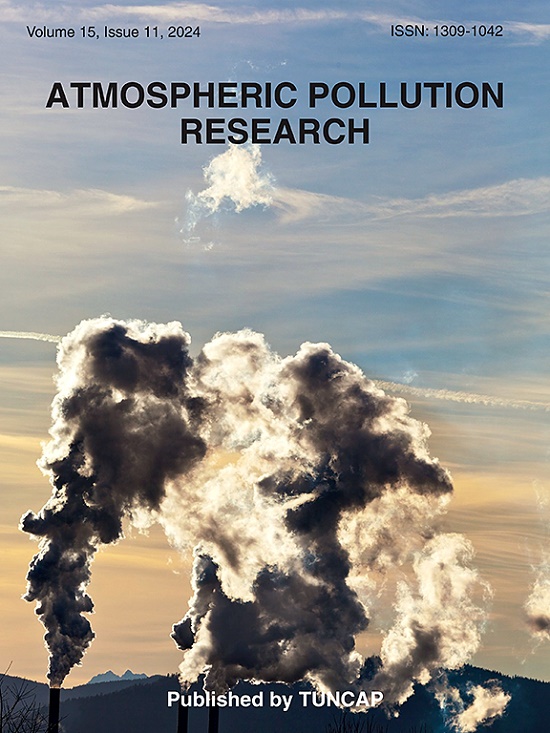Inhalation risk assessment on 14 organic chemicals in children's masks based on the Monte Carlo stochastic modeling method
IF 3.9
3区 环境科学与生态学
Q2 ENVIRONMENTAL SCIENCES
引用次数: 0
Abstract
Children are a relatively vulnerable group, and their health has received widespread attention. However, understanding of the types of pollutants in children's products and the associated health risks remains limited. In this study, the release concentrations of 14 inhalable organics in children's masks made of polyvinyl chloride, ethylene-vinyl acetate co-polymer, and polyvinyl acetate materials were measured by air bag method, and the health risk assessment of these substances was carried out based on Monte Carlo method. The results indicated that cyclohexanone, p/m-xylene, o-xylene and ethylbenzene were the several pollutants with the highest release concentrations, the average release concentration of cyclohexanone in polyvinyl chloride, ethylene-vinyl acetate co-polymer and polyvinyl acetate were 5.76 mg m−3, 0.14 mg m−3, 4.60 mg m−3, respectively, p/m-xylene concentrations were 1.32 mg m−3, 0.67 mg m−3, 1.84 mg m−3, respectively, o-xylene concentrations were 1.91 mg m−3, 0.56 mg m−3, 2.37 mg m−3, respectively, ethylbenzene concentrations were 1.26 mg m−3, 0.84 mg m−3, 2.10 mg m−3, respectively. The acute risks of children's masks were assessed and none were found to pose an acute risk. The overall carcinogenic risk and the carcinogenic risks of benzene and carbon tetrachloride did not exceed the limit. However, the overall non-carcinogenic risks of the three materials of children's masks (HQ: 10.22–20.38) exceed the limit value, which will cause harm to children's health. Specifically, xylene, 1-butanol and 1, 3, 5-trimethylbenzene in polyvinyl chloride and polyvinyl acetate materials (HQ: 1.86–18.07), as well as xylene (HQ:6.35) and 1, 3, 5-trimethylbenzene (HQ:4.84) ethylene-vinyl acetate co-polymer material.
基于蒙特卡罗随机建模方法的儿童口罩中14种有机化学品吸入风险评估
儿童是一个相对脆弱的群体,其健康受到广泛关注。然而,对儿童产品中污染物的种类和相关的健康风险的了解仍然有限。本研究采用安全气囊法测定了聚氯乙烯、乙烯-醋酸乙烯共聚物和聚醋酸乙烯材料制成的儿童口罩中14种可吸入有机物的释放浓度,并基于蒙特卡罗法对这些物质进行了健康风险评估。结果表明,环己酮、对/间二甲苯、邻二甲苯和乙苯是释放浓度最高的污染物,环己酮在聚氯乙烯、乙烯-醋酸乙烯共聚物和聚醋酸乙烯中的平均释放浓度分别为5.76 mg m−3、0.14 mg m−3、4.60 mg m−3,对/间二甲苯的平均释放浓度分别为1.32 mg m−3、0.67 mg m−3、1.84 mg m−3,邻二甲苯的平均释放浓度分别为1.91 mg m−3、0.56 mg m−3、2.37 mg m−3。乙苯浓度分别为1.26 mg m−3、0.84 mg m−3、2.10 mg m−3。对儿童口罩的急性风险进行了评估,没有发现儿童口罩构成急性风险。总体致癌风险和苯、四氯化碳的致癌风险均未超标。然而,儿童口罩(HQ: 10.22-20.38)的三种材料的整体非致癌风险超过了限值,会对儿童健康造成危害。具体来说,聚氯乙烯和聚醋酸乙烯材料(HQ: 1.86-18.07)中的二甲苯、1-丁醇和1,3,5 -三甲苯,以及二甲苯(HQ:6.35)和1,3,5 -三甲苯(HQ:4.84)乙烯-乙酸乙烯共聚物材料。
本文章由计算机程序翻译,如有差异,请以英文原文为准。
求助全文
约1分钟内获得全文
求助全文
来源期刊

Atmospheric Pollution Research
ENVIRONMENTAL SCIENCES-
CiteScore
8.30
自引率
6.70%
发文量
256
审稿时长
36 days
期刊介绍:
Atmospheric Pollution Research (APR) is an international journal designed for the publication of articles on air pollution. Papers should present novel experimental results, theory and modeling of air pollution on local, regional, or global scales. Areas covered are research on inorganic, organic, and persistent organic air pollutants, air quality monitoring, air quality management, atmospheric dispersion and transport, air-surface (soil, water, and vegetation) exchange of pollutants, dry and wet deposition, indoor air quality, exposure assessment, health effects, satellite measurements, natural emissions, atmospheric chemistry, greenhouse gases, and effects on climate change.
 求助内容:
求助内容: 应助结果提醒方式:
应助结果提醒方式:


